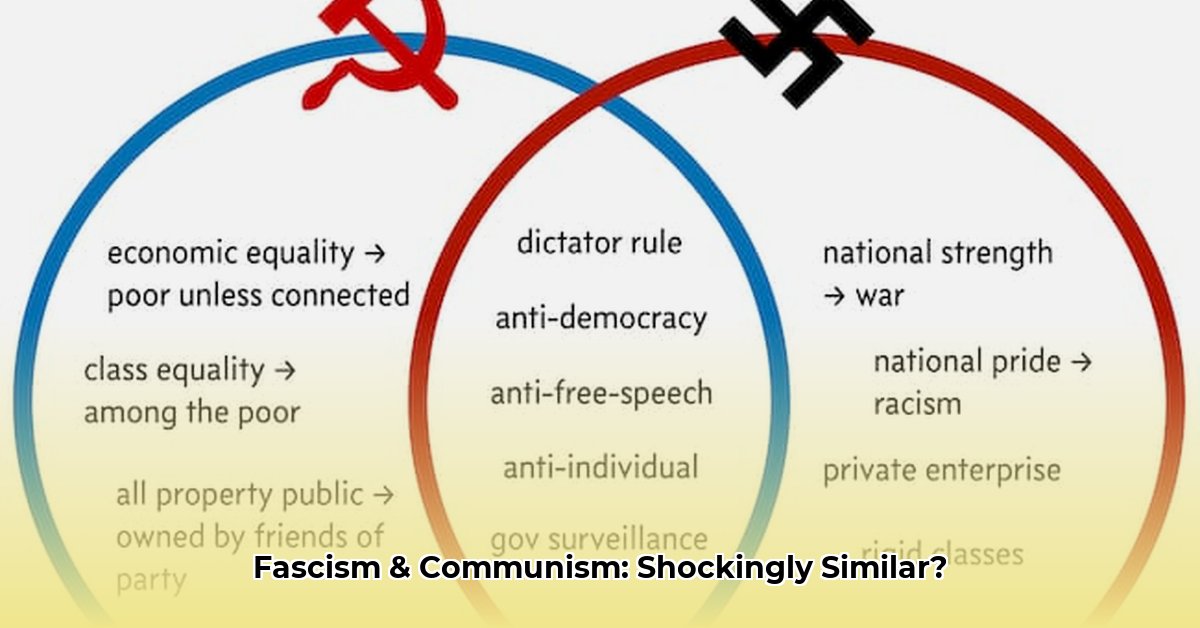
Fascism and communism, often perceived as diametrically opposed ideologies, surprisingly share unsettling commonalities. While their ultimate goals differed – one prioritizing national supremacy, the other advocating classless equality – their methods of achieving power and maintaining control reveal alarming parallels. This analysis explores these similarities, highlighting the crucial distinctions that ultimately set them apart.
Shared Characteristics: Totalitarianism and the Pursuit of Power
Both fascism and communism, born from the socio-political turmoil of the early 20th century, rejected gradual societal change through democratic processes. They promised radical transformation, albeit with contrasting utopian visions. This shared rejection of incremental progress paved the way for similar, authoritarian methodologies.
The Dismantling of Existing Structures
Both ideologies advocated for the complete overthrow of existing social and political structures. They envisioned a fundamental reshaping of society, necessitating the demolition of established institutions. This often involved the use of violence and suppression of dissent, a stark similarity despite their differing ideological justifications. The extent of this disruption, however, varied greatly in practice.
The Pursuit of Absolute Control: Totalitarianism
Perhaps the most striking similarity lies in their pursuit of absolute power – totalitarianism. Both systems sought to control every aspect of citizens' lives. Individual freedom was suppressed, dissent was brutally crushed, and any form of independent thought was perceived as a threat to the regime. The extent of state control, while complete in both cases, manifested differently in practice.
Propaganda as a Tool of Control
Both fascist and communist regimes leveraged propaganda to shape public opinion and solidify their authority. They used carefully orchestrated messaging—through rallies, media control, and pervasive posters—to create a climate of unwavering loyalty and suppress opposition. The content of the propaganda, however, reflected their respective ideological goals.
The Cult of Personality: The Leader as Incarnation of Ideology
Both systems cultivated a cult of personality around their leaders – figures portrayed as infallible saviors with almost god-like authority. This carefully constructed image served to consolidate power and legitimize extreme actions. Leaders were presented as the embodiments of the nation (fascism) or the proletariat (communism), the indispensable agents of societal transformation.
The Brutal Suppression of Opposition
The consequences of this unchecked power were horrifically similar in both systems. Both fascism and communism employed widespread violence, terror, and persecution to maintain control. Political opponents, ethnic minorities, and any perceived threats were ruthlessly eliminated. This resulted in mass killings, forced labor, and unimaginable human suffering, manifested in institutions like the Soviet Gulags and Nazi concentration camps. While the targets of persecution differed, the brutality of the methods was strikingly similar.
Key Differences: Economic Systems and Ideological Goals
Despite their shared authoritarian tendencies, crucial differences distinguish fascism and communism. These variations, rooted in their differing economic philosophies and ultimate goals, significantly shaped their historical manifestations.
Contrasting Economic Systems
The fundamental difference lies in their economic approaches. Communism aimed for a classless society with collective ownership of the means of production, advocating for a centrally planned economy. Fascism, while maintaining private property, implemented a state-controlled mixed economy, where the government directed resource allocation and industrial production.
Diverging Ideological Goals
Communism sought to establish a classless society, eliminating exploitation and promoting equality. This involved international revolution and the eventual withering away of the state. Fascism, conversely, championed the nation-state, advocating for national unity and racial purity, often through expansionism and military power.
A Comparative Table: Highlighting Similarities and Differences
| Feature | Communism | Fascism |
|---|---|---|
| Primary Goal | Classless society, global proletarian revolution | National unity, racial purity, expansionism |
| Economic System | Centrally planned, collective ownership | State-controlled mixed economy |
| Leadership Style | Charismatic, one-party rule | Charismatic, one-party rule |
| Control Mechanisms | Propaganda, terror, suppression | Propaganda, terror, suppression |
| Treatment of Opposition | Brutally suppressed, often through liquidation | Brutally suppressed, often through liquidation |
| International Relations | International revolution, anti-capitalism | Aggressive nationalism, potential alliances |
In conclusion, while both fascism and communism manifested as totalitarian systems with similar methods of control, their fundamental ideological goals and economic approaches diverged significantly. Understanding these similarities and differences is crucial for comprehending the historical impact of both ideologies and for preventing the recurrence of such oppressive regimes. The study of these ideologies continues, requiring ongoing critical analysis and contextual understanding.